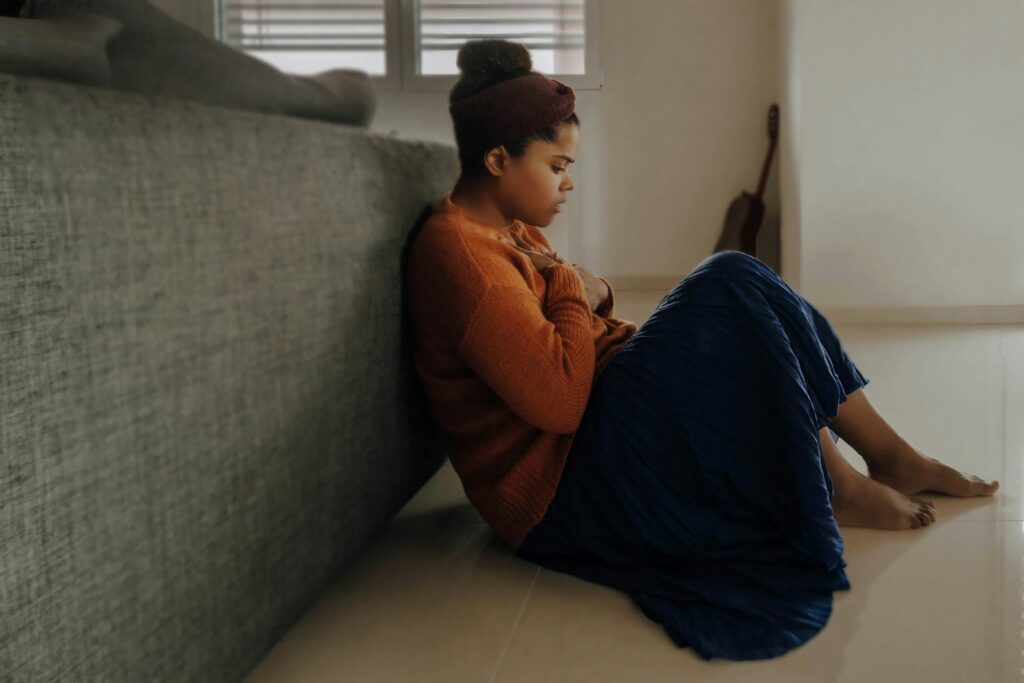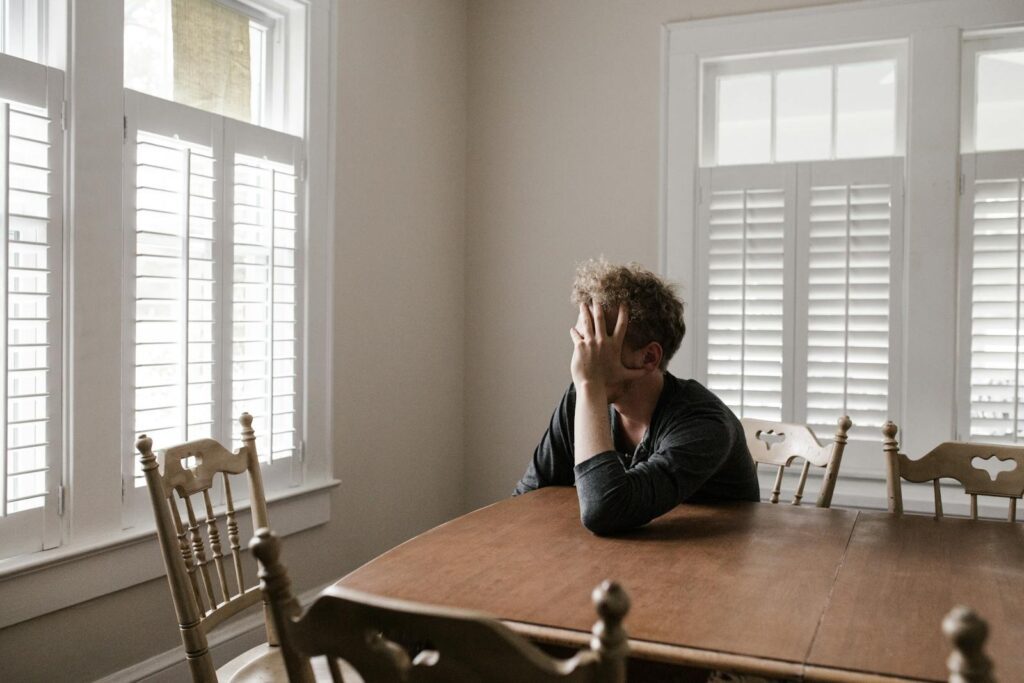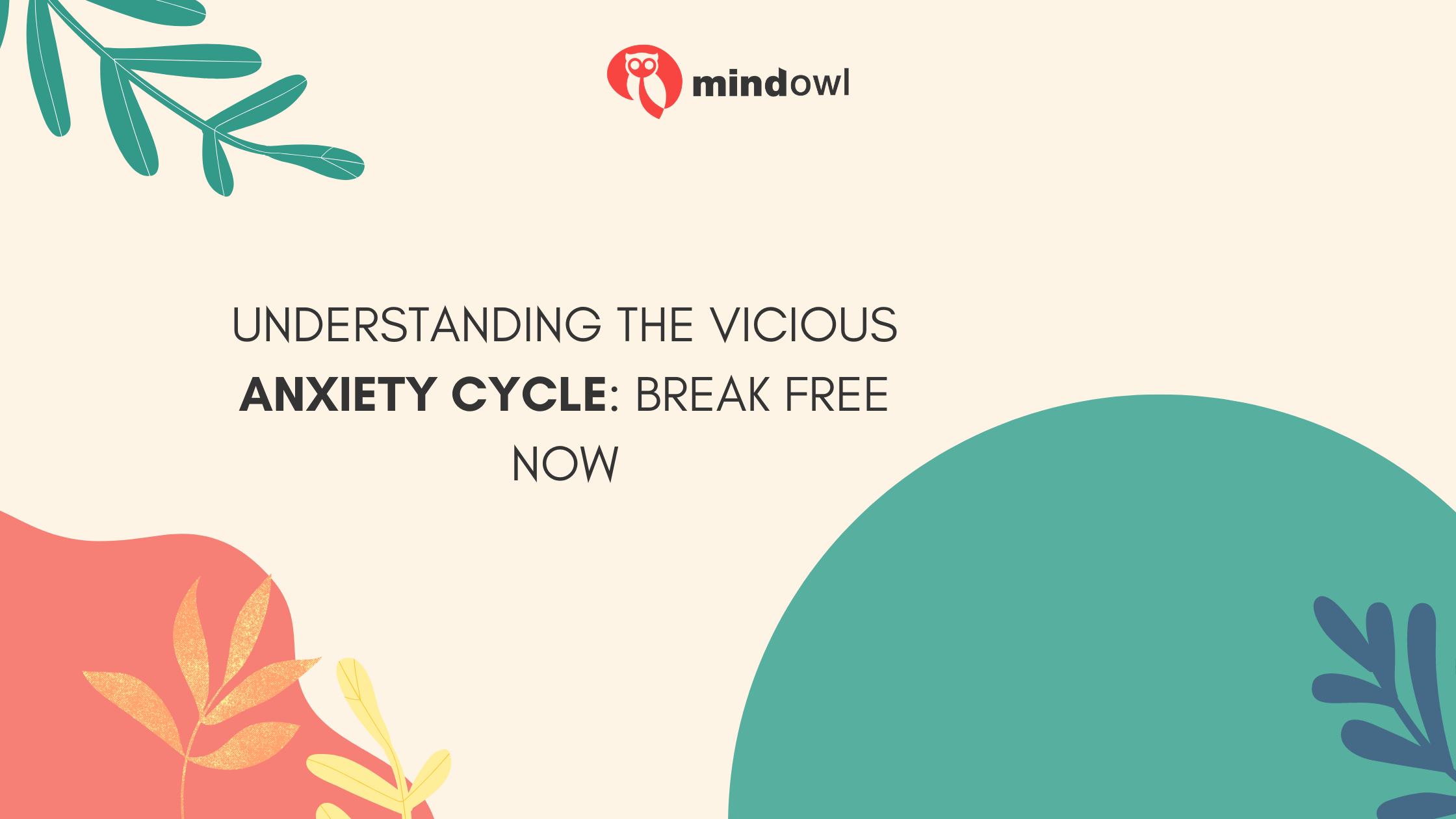Feeling trapped in a cycle of anxiety can often seem like you’re stuck on a never-ending carousel. The more we try to fight or flee from these feelings, the tighter their grip seems to grow.
This is something many of us face daily but finding our way out can feel overwhelming. Did you know that recognising and understanding this cycle is one of the first steps towards breaking free?
Our blog today shines a light on the vicious cycle of anxiety – from what sparks it into motion to how avoidance behaviours throw fuel on its fire. We’ll guide you through identifying its four stages, understand the symptoms it manifests, and most importantly, share strategies for breaking free.
You’ll find practical advice backed by cognitive behavioural therapy (CBT) insights designed not only to help manage your anxiety but also reverse the cycle altogether. Ready for change? Keep reading!
Key Takeaways
- The anxiety cycle starts with a trigger, leading to physical symptoms and negative thoughts that increase anxiety.
- Avoidance and safety behaviours may seem helpful but actually keep the cycle going by preventing real coping.
- Spotting early warning signs of anxiety allows you to interrupt the cycle before it worsens.
- Facing fears directly instead of avoiding them reduces long-term anxiety.
- Coping mechanisms like deep breathing, mindfulness, and therapy can help manage anxiety effectively.

Understanding the Cycle of Anxiety
The Vicious Cycle of Anxiety
The vicious cycle of anxiety starts with a trigger, something that makes you feel anxious. This could be anything from thinking about an upcoming event to encountering a feared situation.
Once the trigger kicks in, your body responds with physical symptoms of anxiety, like sweating or difficulty breathing. Your mind then interprets these physical sensations as danger, which fuels more anxious thoughts.
These negative thoughts increase your anxiety even further, creating a loop that can be hard to break.
Avoidance and safety behaviours may offer short-term relief but ultimately reinforce the cycle by preventing you from learning to cope with anxiety in the moment.
For example, if you avoid situations that make you anxious or rely on safety behaviours to get through them, you never get to experience being okay in those situations. This lack of experience then feeds back into the cycle—you continue to believe that these situations are dangerous and beyond your ability to manage because you’ve never had evidence to prove otherwise.
The Role of Avoidance and Safety Behaviours
Avoidance and safety behaviours play a key role in keeping the anxiety cycle spinning. Many people use these strategies to cope with their fears, thinking it will shield them from anxiety.
Yet, this short-term relief has a price. It stops them from facing their fears head-on, which can reduce anxiety over time. Instead of feeling braver, they find themselves stuck in a loop of avoiding situations that make them uncomfortable.
However, it only leads to more isolation and increased anxiety about future gatherings. Recognising such behaviours encourages one to try new coping skills, nudging them towards confronting what scares them rather than running away – laying down stepping stones for managing distress better without becoming dependent on avoidance strategies.
The 4 Stages of an Anxiety Cycle
Understanding the stages of the anxiety cycle is key to breaking free from it. Let’s dive into each stage to see how they contribute to keeping the cycle going.
- Initial Anxiety or Panic – This stage kicks off when you encounter a trigger, something that makes you anxious. Your body might react by entering fight-or-flight mode, making your heart race and your palms sweat. It’s your body’s way of preparing you to face or escape danger, even if there isn’t any real threat.
- Avoidance and Safety Behaviors – To deal with discomfort, you might try avoiding situations that make you anxious or engage in behaviours that make you feel safer but don’t actually solve the problem. For example, constantly checking for exits could be a safety behaviour if fear of being trapped is what triggers your anxiety.
- Temporary Relief – Avoiding fears or using safety behaviours may give short-term relief from anxiety symptoms, which makes you think these strategies are effective solutions. However, this relief doesn’t last because the root cause of your anxiety isn’t addressed.
- Increased Anxiety Sensitivity – The more often you avoid feared situations and rely on safety behaviors, the more sensitive to anxiety triggers you become over time. This increased sensitivity strengthens the belief that avoidance is helpful, making it more likely for this cycle to repeat itself next time an anxiety trigger appears.
Getting familiar with these stages can help you understand why it feels so hard to break the cycle of anxiety and start working toward actions that genuinely reduce its impact on your life.
Physical and Mental Symptoms
Recognising both the physical and mental symptoms associated with the anxiety cycle is crucial for understanding its impact on our lives. These symptoms can range from discomfort to significant mental strain, signalling the body’s and mind’s response to perceived threats or stressors. Here, we lay out the common physical and mental manifestations of the anxiety cycle.
| Physical Symptoms | Mental Symptoms |
|---|---|
|
– Rapid heart rate – Excessive sweating – Trembling or shaking – Shortness of breath – Gastrointestinal discomfort |
– Persistent worry – Fear of impending doom – Difficulty concentrating – Irritability – Feeling on edge |
Facing these symptoms can be both bewildering and exhausting. They serve as indicators that the anxiety cycle is at play, impacting one’s quality of life. Recognising these signs is the first step towards breaking free from the cycle’s grasp.

Reversing the 4 Stages of the Anxiety Cycle
Break free from the anxiety cycle by recognising your triggers and bodily symptoms. Incorporate coping mechanisms such as deep breathing, relaxation techniques, and challenging negative thoughts to regain control over anxiety.
Reversing the four stages of the anxiety cycle is a key step towards breaking free from it. It involves understanding each stage and actively working against its flow.
- Notice the Warning Signs: The first stage usually starts with some warning signs that you’re feeling anxious. These can be physical, like a fast heartbeat, or mental, such as worry about what might happen next. Recognising these early signs gives you a chance to respond before the anxiety escalates.
- Interrupt the Cycle: After spotting these signs, try to interrupt the cycle before it spins out of control. Techniques might include deep breathing or relaxation exercises. These methods help calm your body’s fight or flight response and prevent a full-blown anxiety attack.
- Face Your Fears: Avoidance often makes anxiety worse in the long run. When you feel more confident, start confronting your fears in small, manageable steps. Exposure therapy is a powerful tool here – it gently exposes you to what scares you in a controlled way until those things fear less intimidating.
- Build New Coping Skills: Finally, work on developing new coping mechanisms that don’t rely on avoidance or safety behaviours. Cognitive behavioural therapy (CBT) is particularly effective for this stage because it helps change thought patterns that fuel anxiety cycles. With practice, new ways of thinking and reacting can take hold, offering relief without having to avoid life’s challenges.
Adopting these strategies requires patience and persistence but can significantly diminish worry and its grip on your life.
Coping Mechanisms and Consideration of Therapy
Finding ways to manage anxiety is crucial. Coping mechanisms help you handle uncomfortable symptoms of anxiety more effectively. You could try techniques like deep breathing, staying present through mindfulness, or challenging negative thoughts.
These strategies may make you feel less anxious and increase your confidence in dealing with stressful situations.
Considering therapy for anxiety is another powerful step. A mental health professional can offer support and guidance. They might use cognitive behavioral therapy to help you understand your thoughts and feelings better.
This approach teaches you new ways to respond to anxiety triggers, aiming for a healthier life without the constant battle against anxiety.
Conclusion
Understanding the vicious cycle of anxiety isn’t just about spotting it; it’s about taking bold steps to break free. Knowledge and action go hand in hand here. Realising you’re caught in this loop is your first victory.
Then, choosing to push against avoidance behaviours and seeking support marks the beginning of your journey out. Whether through therapy, building healthier coping mechanisms or both—relief and a sense of control are within reach.
Let’s remember, breaking free is possible with the right tools and determination.
FAQs
1. What exactly is the anxiety cycle?
The anxiety cycle starts when you feel anxious about something, leading to physical symptoms or bodily sensations, like shallow breathing. This makes you more anxious, creating a loop that’s hard to break.
2. Can anyone experience this type of anxiety?
Yes, indeed! Many types of anxiety exist and practically anyone might feel trapped in its cycle at some point. It’s not just you; many people go through similar experiences.
3. How can I tell if I’m stuck in an anxiety cycle?
If you’re experiencing constant worry, finding yourself avoiding situations due to fear, or feeling physical signs of stress without immediate cause — chances are, you’re caught in it. A therapist could help identify these patterns too.
4. Are there effective ways to break free from the cycle?
Absolutely — treatments for anxiety disorders range from evidence-based therapies with a licensed psychologist to learning practical strategies on your own, such as challenging negative thoughts or practising grounding techniques like keeping your feet firmly on the floor.
5. Does avoiding things that make me anxious help in any way?
Short term? Maybe you’ll feel relief… but avoid a situation today and tomorrow? It becomes increasingly likely that avoidance will only feed into the cycle of anxiety making it stronger over time.
6. Where can I find more help or information about managing my anxiety?
Many resources are available online including worksheets designed by therapist aid organisations and articles offering actionable guidance; however reaching out for a free consultation with professionals may provide personalised support tailored just for you.
MindOwl Founder – My own struggles in life have led me to this path of understanding the human condition. I graduated with a bachelor’s degree in philosophy before completing a master’s degree in psychology at Regent’s University London. I then completed a postgraduate diploma in philosophical counselling before being trained in ACT (Acceptance and commitment therapy).
I’ve spent the last eight years studying the encounter of meditative practices with modern psychology.

